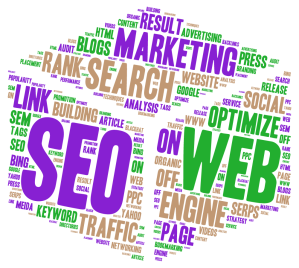Would you like to fill your website with content that your customers love and improves search engine rankings but aren’t yet on first name terms with SEO & Co? No problem – in this guest post, Katharine Eyre presents 5 tips on how you can optimise your web presence with even the smallest of budgets.
Content marketing
The concept of “content marketing” has enjoyed a firm place in US corporate life for several years now; now it is slowly being recognised in Europe. Content marketing is a type of online marketing which does not have the sale of goods and services as its primary objective, but the supply of relevant, informative and entertaining web content to the internet user. This content could take the form of a blog, a white paper or tips for using a product manufactured by the company behind the website.
By offering a continual flow of quality content, the credibility of the company grows – as does the level of trust by the customer. In this way, long term customer relationships are built and maintained. In short: with a well thought-through and consistent content marketing strategy, the chances increase that a visitor to your website becomes a customer and that a one-off commission becomes a long-term business relationship.
Making content marketing work for translators
As a translator, it’s difficult to assert yourself on the market and distinguish yourself from other service providers. However, with good content marketing, it is possible to gain an advantage over the competition.
Since many translators are sole traders who have only small marketing budgets, the production of the right content marketing strategy is a must. Only in this way can you choose and take the most suitable measures for your target group – thus using your available resources in the most efficient and economical way.
With these particularities of the translation industry in mind, I have put together the following 5 content marketing tips for translators.
#1 – Give your website a spring clean!
The first step in any content marketing strategy is to take an inventory of your website. Check for outdated content, “dead” links, contradictions and overlaps. I recommend entering all the pages of your website into an Excel table inventory, recording which content is contained on which page (text, pictures, info-graphics etc.). You can then use this as a basis to decide which content requires amendment, which content should be removed from the website and which new content needs to be produced.
#2 – Make a customer profile
The customer is always at the centre of any content marketing strategy. The content you provide has to gain his interest and keep it. In order to get to know your customer, I recommend putting together a customer profile. This could (for example) cover the following characteristics: age, sex, nationality, job, relationship status or hobbies. The more characteristics your profile considers, the more accurately you can tailor your web content towards the needs and wants of the customer.
#3 – Feed your website regularly
Google loves new content and rewards websites which are constantly updated with fresh content with better rankings in the search results. For you, this means that filling your website with content is no longer a one-off job, but an ongoing project which you have to keep going besides your core translation activities.
If you have a blog, be sure to publish at least one new article every month. Other regular features, such as a “Word of the Week” or information on seminars which you hold, should also be refreshed as often as possible.
#4 – Spread the word
Another method with which you can raise your visibility on the internet is to publish your content on other websites, e.g. networking platforms such as “Xing” or “LinkedIn”. In the marketing business, this technique is referred to as “seeding” – you sow your content on ground belonging to others in the hope that your business will grow.
By seeding your content, you are highlighting your special competencies and skills and are seen by more people – who may well need a translation at some point!
#5 – Thy shalt learn to love SEO
Do not be scared of these three letters! With a little bit of knowledge and a little bit of instinct, you can configure your website in such a way – structurally, technically but above all regarding content – that Google can easily understand and interpret it.
Here, there is no getting around detailed keyword research. By keywords, I mean those fundamental concepts which describe the main content of a website. This also includes word combinations. Which keywords are selected will depend on your customer – think not only about what you offer (e.g. “Translation”, “Italian”, “Arabic”), but also what words the customer may type into the search engine while looking for such services (e.g. “technical translations”, “law”, “German” or “contract”).
Once you have chosen your keywords, it is time to integrate them into your website in the most advantageous way. Use the keywords in titles, headings and descriptions – and be sure to place them at the start of a paragraph.
The use of keywords should, however, remain modest: the number one principle of SEO is always the relevance and readability of the content for the user. Google reacts negatively to the overuse of a specific word and punishes websites for this with lower rankings.
If you would like to learn more about SEO-optimised writing and read German, this article offers further Information.
Start your content marketing campaign today and get web-fit!
Katharine Eyre is a former lawyer, turned content marketing consultant and translator living and working in Vienna, Austria. While she is not busy translating legal texts from German into English, she focuses on building up her content marketing company, Content Instinct (www.contentinstinct.com).
Photo credit: http://www.seolinkbuilding.org/


Thank for these wonderful tips to for creating a good content for SEO purpose.